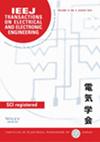求助PDF
{"title":"硅砂中形成的蒸汽弧的瞬态淬火特性:气化二氧化硅混合物对直流电弧熄灭性能的贡献","authors":"Naoto Kodama, Yasunobu Yokomizu, Waku Takenaka, Koya Nakamura","doi":"10.1002/tee.24156","DOIUrl":null,"url":null,"abstract":"<p>The current-limiting fuse uses silica (SiO<sub>2</sub>)-sand as arc quenching medium to increase a current-limiting performance during the DC arc quenching process. In order to increase the current-limiting performance of the fuse, a detailed understanding of an arc resistance <span></span><math>\n <semantics>\n <mrow>\n <msub>\n <mi>r</mi>\n <mi>arc</mi>\n </msub>\n </mrow>\n <annotation>$$ {r}_{\\mathrm{arc}} $$</annotation>\n </semantics></math> rise process is necessary. This paper first carried out a 1000 A DC Cu arc quenching experiment using the silica-sand to obtain transient change in <span></span><math>\n <semantics>\n <mrow>\n <msub>\n <mi>r</mi>\n <mi>arc</mi>\n </msub>\n </mrow>\n <annotation>$$ {r}_{\\mathrm{arc}} $$</annotation>\n </semantics></math>, morphology of the arc, and arc temperature <span></span><math>\n <semantics>\n <mrow>\n <mi>T</mi>\n </mrow>\n <annotation>$$ T $$</annotation>\n </semantics></math> during the arc quenching process. As a result, a current decaying increased <span></span><math>\n <semantics>\n <mrow>\n <msub>\n <mi>r</mi>\n <mi>arc</mi>\n </msub>\n </mrow>\n <annotation>$$ {r}_{\\mathrm{arc}} $$</annotation>\n </semantics></math>. The arc was maintained in the cavity surrounded by the fulgurite during the current decaying process. The temperature of Cu/SiO<sub>2</sub> arc was 25–8 kK at a current region of 950–400 A during the arc quenching process. Second, we theoretically calculated an electrical resistivity <span></span><math>\n <semantics>\n <mrow>\n <mi>ρ</mi>\n </mrow>\n <annotation>$$ \\rho $$</annotation>\n </semantics></math>, and a thermal diffusivity <span></span><math>\n <semantics>\n <mrow>\n <mi>α</mi>\n </mrow>\n <annotation>$$ \\alpha $$</annotation>\n </semantics></math> as vapor properties for the Cu/SiO<sub>2</sub> vapor mixture. As typical results, the admixing of the SiO<sub>2</sub> vapor into the Cu arc less increased <span></span><math>\n <semantics>\n <mrow>\n <mi>ρ</mi>\n </mrow>\n <annotation>$$ \\rho $$</annotation>\n </semantics></math> of the Cu/SiO<sub>2</sub> vapor mixture at <span></span><math>\n <semantics>\n <mrow>\n <mi>T</mi>\n </mrow>\n <annotation>$$ T $$</annotation>\n </semantics></math> between 25 and 5 kK. The <span></span><math>\n <semantics>\n <mrow>\n <mi>ρ</mi>\n </mrow>\n <annotation>$$ \\rho $$</annotation>\n </semantics></math> of the Cu/SiO<sub>2</sub> vapor mixture drastically increased due to only decay in <span></span><math>\n <semantics>\n <mrow>\n <mi>T</mi>\n </mrow>\n <annotation>$$ T $$</annotation>\n </semantics></math>. In contrast, the admixing of the SiO<sub>2</sub> vapor into the Cu arc significantly increased <span></span><math>\n <semantics>\n <mrow>\n <mi>α</mi>\n </mrow>\n <annotation>$$ \\alpha $$</annotation>\n </semantics></math> at <span></span><math>\n <semantics>\n <mrow>\n <mi>T</mi>\n </mrow>\n <annotation>$$ T $$</annotation>\n </semantics></math> between 15 and 8 kK. The present results indicate that an increase in <span></span><math>\n <semantics>\n <mrow>\n <mi>α</mi>\n </mrow>\n <annotation>$$ \\alpha $$</annotation>\n </semantics></math> and consequent rise in thermal energy dissipation from the arc is the main role of the silica-sand vapor mixed with Cu arc in the DC fuse during the arc quenching process. The increased thermal energy dissipation due to the SiO<sub>2</sub> vapor admixing further decreases <span></span><math>\n <semantics>\n <mrow>\n <mi>T</mi>\n </mrow>\n <annotation>$$ T $$</annotation>\n </semantics></math> to rapidly rise <span></span><math>\n <semantics>\n <mrow>\n <mi>ρ</mi>\n </mrow>\n <annotation>$$ \\rho $$</annotation>\n </semantics></math> and <span></span><math>\n <semantics>\n <mrow>\n <msub>\n <mi>r</mi>\n <mi>arc</mi>\n </msub>\n </mrow>\n <annotation>$$ {r}_{\\mathrm{arc}} $$</annotation>\n </semantics></math> during the arc quenching process. © 2024 Institute of Electrical Engineers of Japan and Wiley Periodicals LLC.</p>","PeriodicalId":13435,"journal":{"name":"IEEJ Transactions on Electrical and Electronic Engineering","volume":"19 12","pages":"1965-1975"},"PeriodicalIF":1.0000,"publicationDate":"2024-07-05","publicationTypes":"Journal Article","fieldsOfStudy":null,"isOpenAccess":false,"openAccessPdf":"","citationCount":"0","resultStr":"{\"title\":\"Transient Quenching Properties of Vapor Arc Formed in Silica Sand: Contribution of Vaporized SiO2 Mixture to DC Arc Extinction Performance\",\"authors\":\"Naoto Kodama, Yasunobu Yokomizu, Waku Takenaka, Koya Nakamura\",\"doi\":\"10.1002/tee.24156\",\"DOIUrl\":null,\"url\":null,\"abstract\":\"<p>The current-limiting fuse uses silica (SiO<sub>2</sub>)-sand as arc quenching medium to increase a current-limiting performance during the DC arc quenching process. In order to increase the current-limiting performance of the fuse, a detailed understanding of an arc resistance <span></span><math>\\n <semantics>\\n <mrow>\\n <msub>\\n <mi>r</mi>\\n <mi>arc</mi>\\n </msub>\\n </mrow>\\n <annotation>$$ {r}_{\\\\mathrm{arc}} $$</annotation>\\n </semantics></math> rise process is necessary. This paper first carried out a 1000 A DC Cu arc quenching experiment using the silica-sand to obtain transient change in <span></span><math>\\n <semantics>\\n <mrow>\\n <msub>\\n <mi>r</mi>\\n <mi>arc</mi>\\n </msub>\\n </mrow>\\n <annotation>$$ {r}_{\\\\mathrm{arc}} $$</annotation>\\n </semantics></math>, morphology of the arc, and arc temperature <span></span><math>\\n <semantics>\\n <mrow>\\n <mi>T</mi>\\n </mrow>\\n <annotation>$$ T $$</annotation>\\n </semantics></math> during the arc quenching process. As a result, a current decaying increased <span></span><math>\\n <semantics>\\n <mrow>\\n <msub>\\n <mi>r</mi>\\n <mi>arc</mi>\\n </msub>\\n </mrow>\\n <annotation>$$ {r}_{\\\\mathrm{arc}} $$</annotation>\\n </semantics></math>. The arc was maintained in the cavity surrounded by the fulgurite during the current decaying process. The temperature of Cu/SiO<sub>2</sub> arc was 25–8 kK at a current region of 950–400 A during the arc quenching process. Second, we theoretically calculated an electrical resistivity <span></span><math>\\n <semantics>\\n <mrow>\\n <mi>ρ</mi>\\n </mrow>\\n <annotation>$$ \\\\rho $$</annotation>\\n </semantics></math>, and a thermal diffusivity <span></span><math>\\n <semantics>\\n <mrow>\\n <mi>α</mi>\\n </mrow>\\n <annotation>$$ \\\\alpha $$</annotation>\\n </semantics></math> as vapor properties for the Cu/SiO<sub>2</sub> vapor mixture. As typical results, the admixing of the SiO<sub>2</sub> vapor into the Cu arc less increased <span></span><math>\\n <semantics>\\n <mrow>\\n <mi>ρ</mi>\\n </mrow>\\n <annotation>$$ \\\\rho $$</annotation>\\n </semantics></math> of the Cu/SiO<sub>2</sub> vapor mixture at <span></span><math>\\n <semantics>\\n <mrow>\\n <mi>T</mi>\\n </mrow>\\n <annotation>$$ T $$</annotation>\\n </semantics></math> between 25 and 5 kK. The <span></span><math>\\n <semantics>\\n <mrow>\\n <mi>ρ</mi>\\n </mrow>\\n <annotation>$$ \\\\rho $$</annotation>\\n </semantics></math> of the Cu/SiO<sub>2</sub> vapor mixture drastically increased due to only decay in <span></span><math>\\n <semantics>\\n <mrow>\\n <mi>T</mi>\\n </mrow>\\n <annotation>$$ T $$</annotation>\\n </semantics></math>. In contrast, the admixing of the SiO<sub>2</sub> vapor into the Cu arc significantly increased <span></span><math>\\n <semantics>\\n <mrow>\\n <mi>α</mi>\\n </mrow>\\n <annotation>$$ \\\\alpha $$</annotation>\\n </semantics></math> at <span></span><math>\\n <semantics>\\n <mrow>\\n <mi>T</mi>\\n </mrow>\\n <annotation>$$ T $$</annotation>\\n </semantics></math> between 15 and 8 kK. The present results indicate that an increase in <span></span><math>\\n <semantics>\\n <mrow>\\n <mi>α</mi>\\n </mrow>\\n <annotation>$$ \\\\alpha $$</annotation>\\n </semantics></math> and consequent rise in thermal energy dissipation from the arc is the main role of the silica-sand vapor mixed with Cu arc in the DC fuse during the arc quenching process. The increased thermal energy dissipation due to the SiO<sub>2</sub> vapor admixing further decreases <span></span><math>\\n <semantics>\\n <mrow>\\n <mi>T</mi>\\n </mrow>\\n <annotation>$$ T $$</annotation>\\n </semantics></math> to rapidly rise <span></span><math>\\n <semantics>\\n <mrow>\\n <mi>ρ</mi>\\n </mrow>\\n <annotation>$$ \\\\rho $$</annotation>\\n </semantics></math> and <span></span><math>\\n <semantics>\\n <mrow>\\n <msub>\\n <mi>r</mi>\\n <mi>arc</mi>\\n </msub>\\n </mrow>\\n <annotation>$$ {r}_{\\\\mathrm{arc}} $$</annotation>\\n </semantics></math> during the arc quenching process. © 2024 Institute of Electrical Engineers of Japan and Wiley Periodicals LLC.</p>\",\"PeriodicalId\":13435,\"journal\":{\"name\":\"IEEJ Transactions on Electrical and Electronic Engineering\",\"volume\":\"19 12\",\"pages\":\"1965-1975\"},\"PeriodicalIF\":1.0000,\"publicationDate\":\"2024-07-05\",\"publicationTypes\":\"Journal Article\",\"fieldsOfStudy\":null,\"isOpenAccess\":false,\"openAccessPdf\":\"\",\"citationCount\":\"0\",\"resultStr\":null,\"platform\":\"Semanticscholar\",\"paperid\":null,\"PeriodicalName\":\"IEEJ Transactions on Electrical and Electronic Engineering\",\"FirstCategoryId\":\"5\",\"ListUrlMain\":\"https://onlinelibrary.wiley.com/doi/10.1002/tee.24156\",\"RegionNum\":4,\"RegionCategory\":\"工程技术\",\"ArticlePicture\":[],\"TitleCN\":null,\"AbstractTextCN\":null,\"PMCID\":null,\"EPubDate\":\"\",\"PubModel\":\"\",\"JCR\":\"Q4\",\"JCRName\":\"ENGINEERING, ELECTRICAL & ELECTRONIC\",\"Score\":null,\"Total\":0}","platform":"Semanticscholar","paperid":null,"PeriodicalName":"IEEJ Transactions on Electrical and Electronic Engineering","FirstCategoryId":"5","ListUrlMain":"https://onlinelibrary.wiley.com/doi/10.1002/tee.24156","RegionNum":4,"RegionCategory":"工程技术","ArticlePicture":[],"TitleCN":null,"AbstractTextCN":null,"PMCID":null,"EPubDate":"","PubModel":"","JCR":"Q4","JCRName":"ENGINEERING, ELECTRICAL & ELECTRONIC","Score":null,"Total":0}
引用次数: 0
引用
批量引用

 求助内容:
求助内容: 应助结果提醒方式:
应助结果提醒方式:


